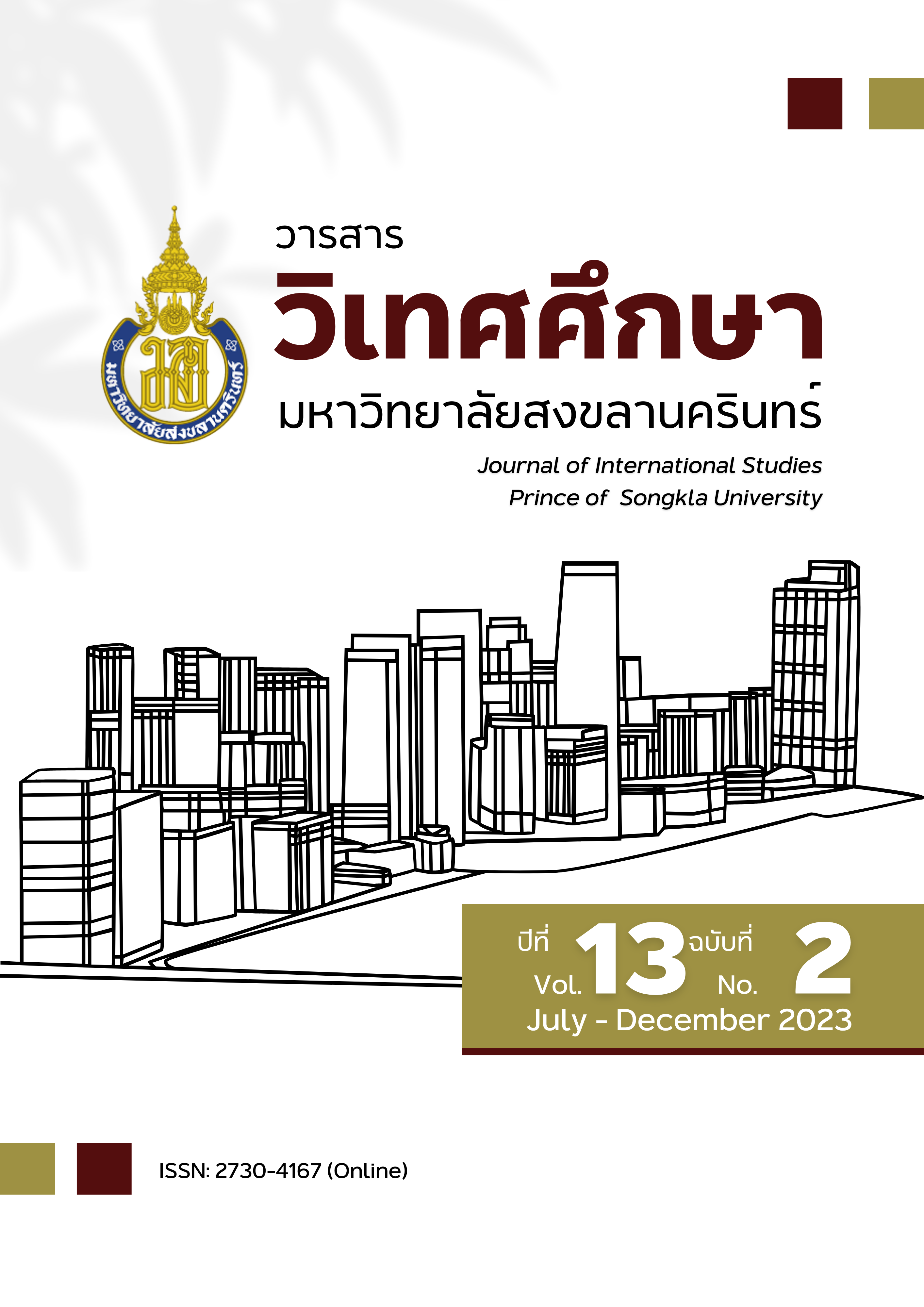A Study of the Guanxi Culture Dependency of the New Chinese Migrants in Phuket
Main Article Content
Abstract
This qualitative research aims to study the dependency of Guanxi culture among new Chinese immigrants living in Phuket, Thailand, by conducting the in-depth interviews with 10 Chinese informants who have lived in Phuket for at least 12 months. It is found that, new Chinese migrants regularly communicate with each other and occasionally assist and reciprocate with each other, which is consistent with some of the essential characteristics of the Guanxi culture. However, such a connection appears to be rather shallow. The participants are not aware of the necessity of relying on each other while living in Phuket. This indicates that the new Chinese community lacks a collective feeling and sense of belonging towards its members. In case of having problems, they put their own effort to obtain sufficient and reliable information and solution. Additionally, they trust the Thai legal system that is more inclusive of foreigner’s’ right compared to that of the past. The results also reveal that the new Chinese migrants lack mutual trust and confidence in one another due to the fact that they have just recently become acquainted with each other. As a result, the dependency of Guanxi culture among new Chinese immigrants tends to decrease.
Article Details

This work is licensed under a Creative Commons Attribution-NonCommercial-NoDerivatives 4.0 International License.
Statements and opinions expressed in articles herein are those of the authors and do not necessarily reflect the position of the editors or publisher.
Article, information, text, image, etc. which are published in Journal of International Studies, belong to Journal of International Studies. If anybody or any organization would like to use part or whole of them, they must receive written permission from Journal of International Studies before usage.
References
กองบรรณาธิการศิลปวัฒนธรรม. (2566). ชาวจีนอพยพใหม่ เหมือน-แตกต่าง จากชาวจีนโพ้นทะเลอย่างไร. ศิลปวัฒนธรรม. https://www.silpa-mag.com/history/article_67998
เธียรชัย เอี่ยมวรเมธ. (2548). พจนานุกรมจีน-ไทย ฉบับใหม่ (พิมพ์ครั้งที่ 14). รวมสาส์น.
วันจรัตน์ เคชวิลัย และนาฏกานต์ ดิลท์ส. (2566). การมีปฏิสัมพันธ์กับการสร้างอัตลักษณ์ของคนไทยเชื้อสายจีนในภูเก็ต. วารสารวิชาการนอร์ทเทิร์น, 10(1), 83-99.
Bao, J. (2005). Chinese in Thailand. In Ember, M., Ember, C.R., & Skoggard, I. (Eds). Encyclopedia of Diasporas (pp. 751-759). Springer.
Berger, R., Herstein, R., Silbiger, A., & Barnes, B. R. (2015). Can guanxi be created in Sino–Western relationships? An assessment of Western firms trading with China using the GRX scale. Industrial Marketing Management, 47, 166-174.
Blau, P. (1964). Exchange and Power in Social Life. Willey.
Chung, W.-K., & Hamilton, G. G. (2001). Social Logic as Business Logic: Guanxi, Trustworthiness, and the Embeddedness of Chinese Business Practices. In R. P. Appelbaum, W. L. Felstiner, & V. Gessner, Rules and Networks: The Legal Culture of Global Business Transactions (pp. 325-346). Hart Publishing.
Gold, T., Guthrie, D., & Wang, D. (2004). An Introduction to the Study of Guanxi. In T. Gold, D. Guthrie, & D. Wang, Social Connection in China: Institution, Culture, and the Changing Nature of Guanxi (pp. 3-20). Cambridge University Press.
Gu, F. F., Hung, K., & Tse, D. K. (2008, July). When Does Guanxi Matter? Issues of Capitalization and Its Dark Sides. Journal of Marketing, 72, 12-28.
Guitong Ma, ศุภการ ศิริไพศาล, และ อดิศร ศักดิ์สูง. (2561). วัฒนธรรมกวนซี่กับการสร้างเครือข่ายทางสังคมของชาวไทยเชื้อสายจีนฮากกาในพื้นที่ภาคใต้ตอนล่างประเทศไทย. อินทนิลทักษิณสาร, 13(2), 139-163.
Homans, G. C. (1958). Social Behaviour as Exchange. American Journal of Society, 63(6), 597-606.
Jiang, J. P. (1966, Mar). The Chinese in Thailand: Past and Present. Journal of Southeast Asian History, 7(1), 39-65.
Keister, L. A. (2004). Guanxi in Business Groups: Social Ties and the Formation of Economic Relations. In T. Gold, D. Guthrie, & D. Wank, Social Connections in China: Institution, Culture, and the Changing in Nature of Guanxi (2nd ed., pp. 77-86). Cambridge University Press.
Langenberg, E. A. (2007). Guanxi and Business Strategy: Theory and Implications for Multinational Companies in China. Physica-Verlag.
Lockard, C. A. (2013). Chinese Migration and Settlement in Southeast Asia before 1850: Making Fields from the Sea. History Compass, 11(9), 765-781.
Luo, Y. (2007). Guanxi and Business (2nd ed.). World Scientific.
McCurry, J., & Kollewe, J. (2011, February 14). The Guardian. https://www.theguardian.com/business/2011/feb/14/china-second-largest-economy
National Bureau of Statistics. (2021). Annual Data. https://data.stats.gov.cn/easyquery.htm?cn=C01&zb=A0M0A&sj=2021
Patranobis, S. (2013, February 18). Lack of trust between people plaguing Chinese society. Hindustan Times. https://www.hindustantimes.com/world/lack-of-trust-between-people-plaguing-chinese-society/story-YDp456MQzIbkUKZutIg2bP.html
Rae, I., & Witzel, M. (2008). Chinese of South East Asia: History, Culture, Business. Palgrave Macmillan.
Siriphon, A. (2015). Xinyimin, New Chinese Migrants, and the Influence of the PRC and Taiwan on the Northern Thai Border. In Y. Santasombat, Impact of China's Rise on the Mekong Region (pp. 147-166). Palgrave Macmillan.
Siriphon, A. (2019). Developing Entrepreneurship Under the Rise of China: Chinese Migrant Entrepreneurs in Tourism-Related Business in Chiang Mai. In Y. Santasombat, The Sociology of Chinese Capitalism in Southeast Asia (pp. 271-289). Palgrave Macmillan.
Skinner, W. G. (1957). Chinese Society in Thailand: An Analytic History. Cornell University Press.
Sng, J., & Bisalputra, P. (2015). A History of the Thai-Chinese. Edition Didier Millet.
Suryadinata, L. (2017). The Rise of China and the Chinese Overseas: A Study of Beijing's Changing Policy in Southeast Asia and Beyond. ISEAS Publishing.
Textor, C. (2022, December 6). Selected countries with the largest number of overseas Chinese 2021. Statista. https://www.statista.com/statistics/279530/countries-with-the-largest-number-of-overseas-chinese/
Textor, C. (2023, May 1). Per capita gross domestic product (GDP) in China in 2022, by province or region. Statista. https://www.statista.com/statistics/1093666/china-per-capita-gross-domestic-product-gdp-by-province/
Macroeconomics. (2023, April 28). BOI. https://www.boi.go.th/index.php?page=macroeconomics
Wang, G. (2000). The Chinese Overseas: From Earthbound China to the Quest for Autonomy. Harvard University Press.
World Bank. (2022). GDP per capita (current $US) - China. https://data.worldbank.org/indicator/NY.GDP.PCAP.CD?locations=CN
Yu, S., & Hale, T. (2021, December). China fights a financial fraud explosion. Financial Times. https://www.ft.com/content/77f61cf0-5b9d-4ea8-854a-4f220039dcb7


